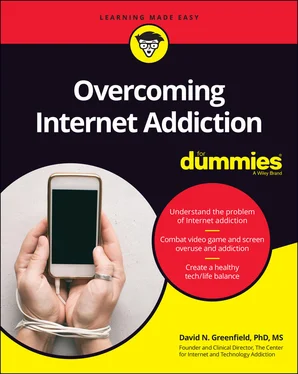All organisms are wired to maximize pleasure and minimize pain. This makes sense on many levels, especially when you understand that pleasure equals survival in terms of our brain’s evolutionary biology (as I explain earlier in this chapter). Of course, it is understood that we as humans are not simply driven by pleasure; we have many other drives and desires that can transcend our more basic biological nature, but sometimes, some of us get stuck on the pleasure merry-go-round.
 The reward center of the brain is largely selective to the neurotransmitter dopamine, which is an excitatory brain chemical, while the frontal lobes are more inhibitory and are designed to counteract some of these excitatory effects (the main frontal lobe brain chemical is GABA, or gamma-aminobutyric acid). You ideally need both brain chemicals, but addiction can skew your nervous system in the pleasure direction of this delicate balance and tip the scales in favor of dopamine and pleasure, while ignoring the rationality and reason of your frontal lobes. This imbalance is more likely to occur during adolescence and young adulthood due to the brain being immature. The balance between pleasure and self-control is necessary for mature development, but too much of a good thing (dopamine pleasure) can increase the likelihood of an addiction and produce a negative impact on real-time living. Flip to Chapter 4for more details.
The reward center of the brain is largely selective to the neurotransmitter dopamine, which is an excitatory brain chemical, while the frontal lobes are more inhibitory and are designed to counteract some of these excitatory effects (the main frontal lobe brain chemical is GABA, or gamma-aminobutyric acid). You ideally need both brain chemicals, but addiction can skew your nervous system in the pleasure direction of this delicate balance and tip the scales in favor of dopamine and pleasure, while ignoring the rationality and reason of your frontal lobes. This imbalance is more likely to occur during adolescence and young adulthood due to the brain being immature. The balance between pleasure and self-control is necessary for mature development, but too much of a good thing (dopamine pleasure) can increase the likelihood of an addiction and produce a negative impact on real-time living. Flip to Chapter 4for more details.
 Addiction is not simply the physical dependence on an intoxicating drug or behavior. Rather, addiction involves changes in motivation, learning, mood, life balance, social relationships, negative health impacts, and decreased work or school productivity. With specific regard to Internet addiction, there can be an all-encompassing preoccupation with screens and the content consumed online.
Addiction is not simply the physical dependence on an intoxicating drug or behavior. Rather, addiction involves changes in motivation, learning, mood, life balance, social relationships, negative health impacts, and decreased work or school productivity. With specific regard to Internet addiction, there can be an all-encompassing preoccupation with screens and the content consumed online.
OUT IN THE WILD: ADDICTIONS IN ANIMALS
Addiction appears in nature in some ways, but not exactly as we see it in humans. There are many reports of animals that seek out psychoactive plants and herbs that essentially get them high; however, keep in mind that addiction is not simply about a substance or a behavior, but rather about an imbalance in life functioning that involves mind, body, and behavior. The evidence suggests that animals do seek out plants that are intoxicating, and the effects seem obvious — for example, elephants lying about lazily after consuming an intoxicating plant — but I am not aware of any evidence that engaging in these behaviors becomes as problematic as it can be for humans.
The reason for this difference seems clear: Humans require a far more complex set of behaviors to function than do animals, and we require balance across many life domains to stay healthy.
Exploring tolerance, withdrawal, triggers, and relapse
Addiction is often associated with several key behaviors that frequently highlight the addictive process. Some of these processes are relevant to Internet addiction, but in a manner that is specific to screen overuse.
Tolerance and withdrawal are terms that we use in addiction medicine to describe the impact of a substance or behavior on our physical and psychological functioning:
Tolerance is a technical term to describe how the body (including the brain) develops decreased sensitivity to the intoxicating effect of a substance or behavior (such as Internet use); the effect of this decreased sensitivity is that it takes more of a drug or behavior to achieve the same degree of intoxicating effect. By intoxicating, I include the subsequent elevation of dopamine. This is a natural process and involves regulation of post-synaptic receptors mostly found in the nucleus accumbens. It’s important to note that most of the time, we are unaware that we’re developing a tolerance; to others who may be observing, it may seem obvious, but this is often a gradual process that goes on without the addict being conscious of it.
Withdrawal involves the physical and psychological reaction to decreasing or discontinuing a substance or behavior; as that dose decreases or stops, certain symptoms are experienced. The body and mind have acclimated to a certain level of intoxication and pleasure. Regarding Internet and technology use, the withdrawal effects might be expressed by reduced frustration tolerance, increased irritability, anger, anxiety, social isolation, and depression. Physical expressions of anger and rage have sometimes been noted, including breaking furniture or punching holes in walls. I have seen these withdrawal effects in patients over the years, and they can be quite disheartening to both patients and their families but are typically short-lived. In some cases, especially in adolescents and young adults, withdrawal effects can become quite concerning. Obviously, safety is the number one goal here, and if your child is threatening to self-harm or is damaging property, it might be necessary to obtain support by calling your local crisis intervention line or the police, or by going to the nearest emergency room for an evaluation. Obviously, this is not a desirable place to be, but I have seen some younger patients become so angry and in acute withdrawal that they lose their composure and self-control, and in those cases, it is always better to be safe and to protect yourself and your loved one.
 The degree and amount of tolerance or withdrawal are not the determining factors for evaluating the degree or severity of an addiction. The amount of withdrawal does not indicate whether there is a diagnosis of Internet addiction. Addiction is a complex, biopsychosocial state that involves disruption in physical health, mood, motivation, time management, social relationships, and productivity. You can have an addiction to the Internet and have little or no withdrawal. Indeed, if getting through withdrawal or detoxing from the Internet, video games, or other screen behavior were sufficient, then no one who discontinued Internet or video game overuse would be experience addicted behavior again or experience a relapse, but this isn’t the case.
The degree and amount of tolerance or withdrawal are not the determining factors for evaluating the degree or severity of an addiction. The amount of withdrawal does not indicate whether there is a diagnosis of Internet addiction. Addiction is a complex, biopsychosocial state that involves disruption in physical health, mood, motivation, time management, social relationships, and productivity. You can have an addiction to the Internet and have little or no withdrawal. Indeed, if getting through withdrawal or detoxing from the Internet, video games, or other screen behavior were sufficient, then no one who discontinued Internet or video game overuse would be experience addicted behavior again or experience a relapse, but this isn’t the case.
Triggers are part of every addiction. A trigger is a psychological tickle that excites the reward system in your brain, which remembers the pleasure it felt when it engaged in the addictive behavior. I say “remembers” because part of the reward system includes the hippocampus, which is the part of the brain’s limbic system that is responsible for memory. The other interesting thing to note is that a trigger can elicit an anticipation response for getting that dopamine hit, and in many cases, that anticipatory dopamine hit can be twice as innervating as the dopamine hit from the actual behavior. A trigger is a powerful reminder of a past pleasure and can lead to a complete relapse into an addiction pattern.
Relapse is straightforward — it involves the reactivation of an addiction pattern. Sometimes relapse occurs for no obvious reason, and sometimes it occurs because of a clearly identified trigger. Triggers can be reminders of the addiction or pleasure found in the behavior, or they can be an emotion or a physical need of some type, including being tired, sad, lonely, or hungry. Basically, any imbalance in our well-being can be an indirect trigger for relapse. A big trigger for Internet addicts can simply be boredom, or simply seeing their screen device.
Читать дальше

 The reward center of the brain is largely selective to the neurotransmitter dopamine, which is an excitatory brain chemical, while the frontal lobes are more inhibitory and are designed to counteract some of these excitatory effects (the main frontal lobe brain chemical is GABA, or gamma-aminobutyric acid). You ideally need both brain chemicals, but addiction can skew your nervous system in the pleasure direction of this delicate balance and tip the scales in favor of dopamine and pleasure, while ignoring the rationality and reason of your frontal lobes. This imbalance is more likely to occur during adolescence and young adulthood due to the brain being immature. The balance between pleasure and self-control is necessary for mature development, but too much of a good thing (dopamine pleasure) can increase the likelihood of an addiction and produce a negative impact on real-time living. Flip to Chapter 4for more details.
The reward center of the brain is largely selective to the neurotransmitter dopamine, which is an excitatory brain chemical, while the frontal lobes are more inhibitory and are designed to counteract some of these excitatory effects (the main frontal lobe brain chemical is GABA, or gamma-aminobutyric acid). You ideally need both brain chemicals, but addiction can skew your nervous system in the pleasure direction of this delicate balance and tip the scales in favor of dopamine and pleasure, while ignoring the rationality and reason of your frontal lobes. This imbalance is more likely to occur during adolescence and young adulthood due to the brain being immature. The balance between pleasure and self-control is necessary for mature development, but too much of a good thing (dopamine pleasure) can increase the likelihood of an addiction and produce a negative impact on real-time living. Flip to Chapter 4for more details.










